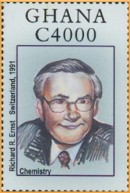Επίσκεψη Richard Ernst
στο Εργαστήριο μας τον Νοέμβριο του 2010, όταν ανακηρύχθηκε επίτιμος διδάκτωρ του Πανεπιστημίου Ιωαννίνων.
Από την επίσκεψη του Ελβετού Νομπελίστα Καθηγητή Χημείας Richard Ernst ( Nobel Χημείας 1991 για την συμβολή του στην Υψηλής Ευκρίνειας φασματοσκοπία NMR ) στο Εργαστήριο μας τον Νοέμβριο του 2010, όταν ανακηρύχθηκε επίτιμος διδάκτωρ του Πανεπιστημίου Ιωαννίνων. Σαν Ακτινολόγοι και ιδιαίτερα σαν ασχολούμενοι με την Μαγνητική Τομογραφία του οφείλουμε πολλά.
{os-gal-2}
 Richard Ernst—Nobel Prize for Nuclear Magnetic Resonance Spectroscopy
Richard Ernst—Nobel Prize for Nuclear Magnetic Resonance Spectroscopy
Marc A. Shampo,a Robert A. Kyle,a and David P. Steensmab
Swiss scientist Richard Robert Ernst was awarded the 1991 Nobel Prize in chemistry for contributions to the development of the method of high-resolution nuclear magnetic resonance (NMR) spectroscopy. Nuclear magnetic resonance was developed in 1945 by 2 American scientists, Felix Bloch (1905-1983) and Edward M. Purcell (1912-1997), who were awarded the 1952 Nobel Prize in physics for their work. Ernst's work not only made NMR spectroscopy a basic and indispensable tool in chemistry but also extended its usefulness to other scientific fields, including physics, biology, and medicine. One of the most widely known applications of NMR is in diagnostic medicine, in which NMR (now magnetic resonance imaging), is a safe, noninvasive way to visualize the interior of the human body. In this capacity, NMR or MRI is well adapted to differentiating between normal and diseased or damaged tissues. It has proved useful for detecting anatomic abnormalities such as tumors and physiologic abnormalities such as blood-starved tissues.
Ernst was born on August 19, 1933, in Winterthur, a suburb of Zurich, Switzerland. His father taught architecture at the technical high school of Winterthur. Ernst had 2 sisters. By the age of 13 years, he had become interested in music and chemistry, but shortly thereafter, he decided to become a chemist rather than a composer.
After completing high school in Winterthur, Ernst enrolled at the Swiss Federal Institute of Technology in Zurich (“the Federal Institute”), and in 1956, he was awarded a diploma in chemistry. He continued his education at the Federal Institute and, in 1962, was awarded a PhD degree. Between obtaining these 2 degrees, Ernst spent time in military service.
After receiving his doctorate, Ernst spent the next year (1962-1963) as a researcher and teacher at the Federal Institute. In 1963, he left Switzerland for the United States to become a research scientist at Varian Associates in Palo Alto, California, where he worked until 1968. In 1968, he returned to Switzerland to join the faculty of the Federal Institute to direct a research group on NMR at the Laboratory of Physical Chemistry, becoming a full professor in 1976.
Ernst's work on NMR spectroscopy began in the early 1960s at the Federal Institute. His contributions to the field—increasing the sensitivity and the resolution of the instruments—have made it possible to determine both the nature of a nucleus and the local structure of the molecule of which the nucleus is a part.
In 1966, Ernst and a colleague found that NMR spectroscopy could be more effective if the slow sweeping radio waves traditionally used to bombard a sample were replaced by short, intense pulses. They used a computer to perform a complex series of mathematical operations (Fourier transformations) in the received signal. This improved the sensitivity by as much as 100-fold. This change (called Fourier transform NMR) has enabled chemists to study more types of nuclei and small amounts of material.
Ernst's second major contribution to the field of NMR spectroscopy was made in the mid-1970s, when he developed 2-dimensional NMR techniques to study exceedingly large molecules. By the 1990s, various NMR techniques were in use to determine the 3-dimensional structure of organic and inorganic compounds and large complex molecules such as proteins; to study the interaction between biologic molecules and metal ions, water molecules, drug molecules, and other substances; to identify chemical species; and to study the rates of chemical reactions.
Ernst is credited with numerous inventions and holds several patents in the field. Besides the Nobel Prize, he has received many honors and awards, including honorary doctorates, the Wolf Prize in Chemistry (1991), and the Louise Gross Horwitz Prize of Columbia University (New York City). In 2002, Ghana issued a stamp (Scott No. 2281d) to honor him as Nobel laureate.



